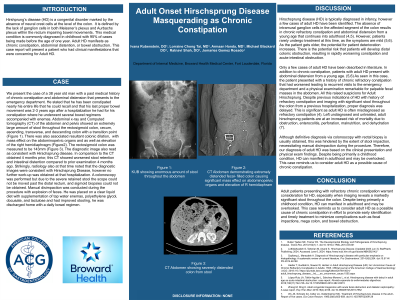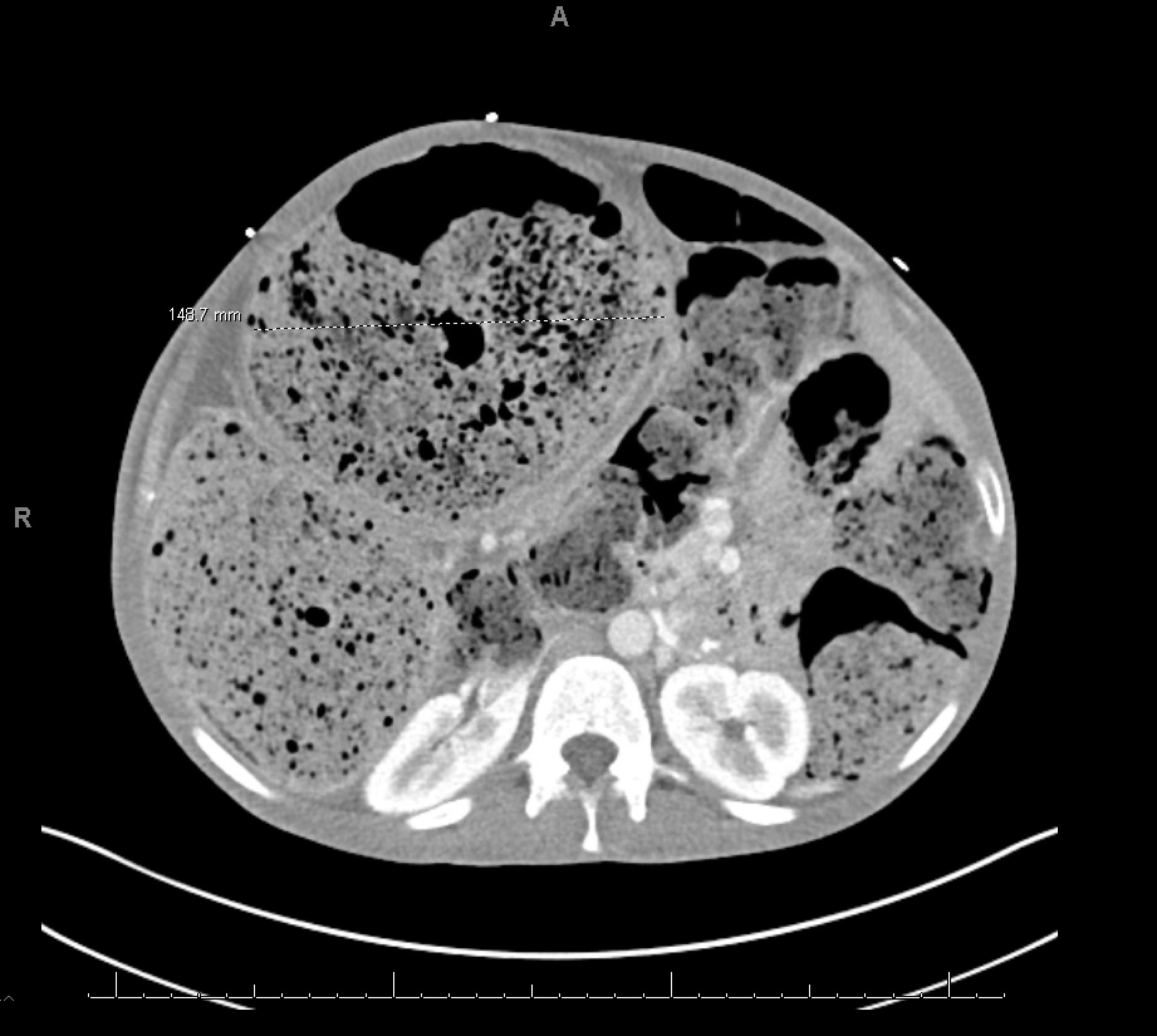Monday Poster Session
Category: Colon
P2057 - Adult Onset Hirschsprung Disease Masquerading as Chronic Constipation
Monday, October 28, 2024
10:30 AM - 4:00 PM ET
Location: Exhibit Hall E

Has Audio

Ivana Rubenstein, DO
Broward Health Medical Center
Fort Lauderdale, FL
Presenting Author(s)
Ivana Rubenstein, DO1, Michael F. Blackard, DO1, Lorraine Chong Tai, MD1, Ratnavi Shah, DO2, Jomaries O.. Gomez Rosado, 3, Armaan Handa, MD4
1Broward Health Medical Center, Fort Lauderdale, FL; 2Broward Health Medical Center, Davie, FL; 3Nova Southeastern University, Davie, FL; 4HCA Florida Largo Hospital, Weston, FL
Introduction: Hirschsprung disease (HD) is a congenital condition defined by the absence of ganglion cells in the colon typically diagnosed within the first year of life. HD is rarely diagnosed in adulthood and typically manifests as chronic constipation, abdominal distention, or bowel obstruction.
Case Description/Methods: Herein, we present the case of a 38-year-old man with a medical history of chronic constipation that presents to the emergency department for constipation. He stated he has been constipated nearly his entire life that he could recall. Imaging of the abdomen showed an extremely large amount of stool throughout the rectosigmoid colon, cecum, ascending, transverse, and descending colon without a transition point with mass effect on the abdominopelvic organs, and elevation of the right hemidiaphragm (Figure 1). Radiology reading was consistent with Hirschsprung disease also noted on previous abdominal Computed tomography (CT) obtained 4 months prior, however, no further work-up was obtained during the prior hospitalization. During this most recent hospitalization, a colonoscopy was performed, but due to the severe retained stool the scope could not be moved past the distal rectum. Sigmoid biopsies could not be obtained. Manual disimpaction was conducted during the procedure and he was able to be discharged home with a daily bowel regimen.
Discussion: Only a few cases of adult HD have been described in literature. Patients with adult HD present with chronic refractory constipation from a young age with abdominal distention and recurrent visits to the emergency department. Physical examination was remarkable for palpable fecal masses in the abdomen. Despite previous indications of HD, given the history and imaging, proper diagnosis was delayed. This is significant as adult HD is often misdiagnosed as refractory constipation (4). If left undiagnosed and untreated, adult HD patients are at an increased risk of mortality due to obstruction, enterocolitis, perforation, malnutrition, and dehydration (7). Although definitive diagnosis via colonoscopy with rectal biopsy is usually obtained, this was hindered by the extent of stool impaction. Therefore, our diagnosis of adult HD was based on the clinical presentation, physical exam findings, and imaging. Despite being primarily a childhood condition, HD can manifest in adulthood and may be overlooked. This case reminds us to consider adult HD as a possible cause of chronic constipation.

Disclosures:
Ivana Rubenstein, DO1, Michael F. Blackard, DO1, Lorraine Chong Tai, MD1, Ratnavi Shah, DO2, Jomaries O.. Gomez Rosado, 3, Armaan Handa, MD4. P2057 - Adult Onset Hirschsprung Disease Masquerading as Chronic Constipation, ACG 2024 Annual Scientific Meeting Abstracts. Philadelphia, PA: American College of Gastroenterology.
1Broward Health Medical Center, Fort Lauderdale, FL; 2Broward Health Medical Center, Davie, FL; 3Nova Southeastern University, Davie, FL; 4HCA Florida Largo Hospital, Weston, FL
Introduction: Hirschsprung disease (HD) is a congenital condition defined by the absence of ganglion cells in the colon typically diagnosed within the first year of life. HD is rarely diagnosed in adulthood and typically manifests as chronic constipation, abdominal distention, or bowel obstruction.
Case Description/Methods: Herein, we present the case of a 38-year-old man with a medical history of chronic constipation that presents to the emergency department for constipation. He stated he has been constipated nearly his entire life that he could recall. Imaging of the abdomen showed an extremely large amount of stool throughout the rectosigmoid colon, cecum, ascending, transverse, and descending colon without a transition point with mass effect on the abdominopelvic organs, and elevation of the right hemidiaphragm (Figure 1). Radiology reading was consistent with Hirschsprung disease also noted on previous abdominal Computed tomography (CT) obtained 4 months prior, however, no further work-up was obtained during the prior hospitalization. During this most recent hospitalization, a colonoscopy was performed, but due to the severe retained stool the scope could not be moved past the distal rectum. Sigmoid biopsies could not be obtained. Manual disimpaction was conducted during the procedure and he was able to be discharged home with a daily bowel regimen.
Discussion: Only a few cases of adult HD have been described in literature. Patients with adult HD present with chronic refractory constipation from a young age with abdominal distention and recurrent visits to the emergency department. Physical examination was remarkable for palpable fecal masses in the abdomen. Despite previous indications of HD, given the history and imaging, proper diagnosis was delayed. This is significant as adult HD is often misdiagnosed as refractory constipation (4). If left undiagnosed and untreated, adult HD patients are at an increased risk of mortality due to obstruction, enterocolitis, perforation, malnutrition, and dehydration (7). Although definitive diagnosis via colonoscopy with rectal biopsy is usually obtained, this was hindered by the extent of stool impaction. Therefore, our diagnosis of adult HD was based on the clinical presentation, physical exam findings, and imaging. Despite being primarily a childhood condition, HD can manifest in adulthood and may be overlooked. This case reminds us to consider adult HD as a possible cause of chronic constipation.

Figure: Contrast enhanced Computed tomography (CT) of Abdomen and Pelvis showing massive amounts of retained stool with resultant colonic dilatation of 14.87cm, consistent with Hirschprung’s disease.
Disclosures:
Ivana Rubenstein indicated no relevant financial relationships.
Michael Blackard: GeoVax Labs, Inc. – Stock-publicly held company(excluding mutual/index funds). Merck & Co., Inc. – Stock-publicly held company(excluding mutual/index funds). Pfizer Inc. – Stock-publicly held company(excluding mutual/index funds). Pyxis Oncology, Inc. – Stock-publicly held company(excluding mutual/index funds). Quest Diagnostics – Stock-publicly held company(excluding mutual/index funds).
Lorraine Chong Tai indicated no relevant financial relationships.
Ratnavi Shah indicated no relevant financial relationships.
Jomaries Gomez Rosado indicated no relevant financial relationships.
Armaan Handa indicated no relevant financial relationships.
Ivana Rubenstein, DO1, Michael F. Blackard, DO1, Lorraine Chong Tai, MD1, Ratnavi Shah, DO2, Jomaries O.. Gomez Rosado, 3, Armaan Handa, MD4. P2057 - Adult Onset Hirschsprung Disease Masquerading as Chronic Constipation, ACG 2024 Annual Scientific Meeting Abstracts. Philadelphia, PA: American College of Gastroenterology.
